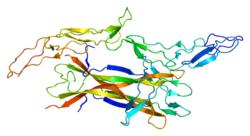The p75 neurotrophin receptor (p75NTR) was first identified in 1973 as the low-affinity nerve growth factor receptor (LNGFR)[5][6] before discovery that p75NTR bound other neurotrophins equally well as nerve growth factor.[7][8] p75NTR is a neurotrophic factor receptor. Neurotrophic factor receptors bind Neurotrophins including Nerve growth factor, Neurotrophin-3, Brain-derived neurotrophic factor, and Neurotrophin-4. All neurotrophins bind to p75NTR. This also includes the immature pro-neurotrophin forms.[9][10] Neurotrophic factor receptors, including p75NTR, are responsible for ensuring a proper density to target ratio of developing neurons, refining broader maps in development into precise connections. p75NTR is involved in pathways that promote neuronal survival and neuronal death.[7]
- ^ a b c GRCh38: Ensembl release 89: ENSG00000064300 – Ensembl, May 2017
- ^ a b c GRCm38: Ensembl release 89: ENSMUSG00000000120 – Ensembl, May 2017
- ^ "Human PubMed Reference:". National Center for Biotechnology Information, U.S. National Library of Medicine.
- ^ "Mouse PubMed Reference:". National Center for Biotechnology Information, U.S. National Library of Medicine.
- ^ Johnson D, Lanahan A, Buck CR, Sehgal A, Morgan C, Mercer E, et al. (November 1986). "Expression and structure of the human NGF receptor". Cell. 47 (4): 545–554. doi:10.1016/0092-8674(86)90619-7. PMID 3022937. S2CID 22472119.
- ^ Radeke MJ, Misko TP, Hsu C, Herzenberg LA, Shooter EM (1987). "Gene transfer and molecular cloning of the rat nerve growth factor receptor". Nature. 325 (6105): 593–597. Bibcode:1987Natur.325..593R. doi:10.1038/325593a0. PMID 3027580. S2CID 4342838.
- ^ a b Bibel M, Hoppe E, Barde YA (February 1999). "Biochemical and functional interactions between the neurotrophin receptors trk and p75NTR". The EMBO Journal. 18 (3): 616–622. doi:10.1093/emboj/18.3.616. PMC 1171154. PMID 9927421.
- ^ Frade JM, Barde YA (February 1998). "Nerve growth factor: two receptors, multiple functions". BioEssays. 20 (2): 137–145. doi:10.1002/(SICI)1521-1878(199802)20:2<137::AID-BIES6>3.0.CO;2-Q. PMID 9631659. S2CID 38060583.
- ^ Barker PA (May 2004). "p75NTR is positively promiscuous: novel partners and new insights". Neuron. 42 (4): 529–533. doi:10.1016/j.neuron.2004.04.001. PMID 15157416. S2CID 15080734.
- ^ Chao MV, Bothwell M (January 2002). "Neurotrophins: to cleave or not to cleave". Neuron. 33 (1): 9–12. doi:10.1016/s0896-6273(01)00573-6. PMID 11779474. S2CID 17364992.





